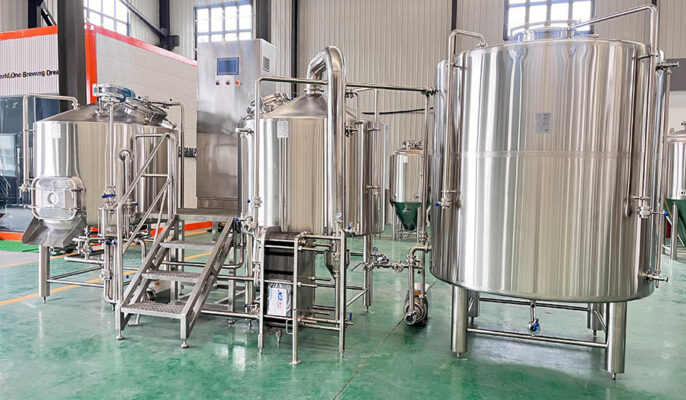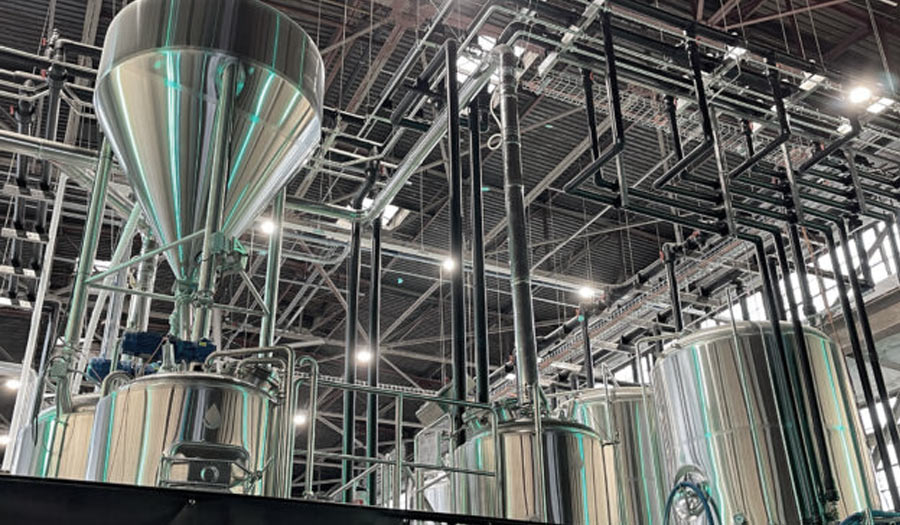Many people love craft beer. It not only has a unique flavor but also allows people to experience the fun of brewing by themselves. To brew high-quality craft beer, it is essential to choose the right brewing equipment and supplies. This article will introduce the basic equipment, other supplies, brewing process, etc. required for brewing craft beer in detail to help you better understand.
Che cos'è la birra artigianale?
Craft beer is a type of beer characterized by traditional methods and small-scale production, usually made by independent brewers or small breweries. Unlike industrialized mass-produced beer, craft beer focuses on the selection of raw materials, the uniqueness of the brewing process, and the diversity of flavors. Craft beer is usually produced by small breweries with relatively small production volumes. This allows brewers to better control the quality of each batch. Traditional brewing methods are usually used, with an emphasis on handcrafting and meticulous craftsmanship to ensure that each bottle of beer has a unique personality. Craft beer is loved by more and more people for its small-scale production, unique flavor, and rich cultural connotations. Whether in terms of taste or brewing concept, craft beer shows the brewer’s creativity and passion for the art of beer.
Heat source selection for craft brewery
In the production process of craft beer, the heat source is a crucial link. It not only affects the brewing efficiency but is also directly related to the quality of the beer. The following are three heat sources:
- Steam heating: Steam heating systems are a popular choice for professional brewers and large commercial breweries. Brewery equipment usually welds the steam jacket to the inner shell. Since the steam jacket is in contact with the equipment, steam can provide the fastest heating speed. As the fastest heating method, the steam jacket requires a lot of initial brewery construction costs to add special pressurized steam jackets, steam traps, and condensate return.
- Electric heating: Electric heating systems are a popular choice for 200L-1000L sistemi di produzione della birra commerciali. Electric heating brewing equipment includes heating tubes in the kettle to ensure the highest heating efficiency. 100% of the heat generated by electric heating will be transferred to the water or wort. This heating method is very common in homemade brewing systems and small commercial breweries, and the temperature can also be easily controlled.
- Direct fire heating: Direct fire heating is a popular choice for home brewers and small commercial breweries. Direct fire heating is a powered gas burner mounted on the outside of the kettle that projects a forced air flame onto a baffle or diffuser in a completely enclosed furnace beneath the kettle. This design greatly reduces the risk of scorching while still providing good temperature control and a heating rate similar to steam heating.
Attrezzature per birra artigianale
Wort barrels
Wort barrels come in many types, from the simplest open containers to closed heating containers equipped with stirring paddles. The more features, the higher the cost. For larger production (above 200 liters or so), it becomes difficult to mix the wort manually. Consider your brewing volume and frequency of use when choosing.
- Material: Stainless steel is the best choice, corrosion-resistant, and easy to clean.
- Capacity: Choose the right capacity according to your needs, and avoid pots that are too small or too large.
- Heating method: Electric heating pot or gas pot, choose according to your usage conditions.
Filter tank
The filter tank is equipped with a filter to separate the sweet wort from the grain. It is also equipped with a flushing ring, which is connected to the HLT via a flow meter. The ability to recirculate hot wort onto the grain is very useful for clarifying the wort before transferring it to the boil kettle. The filter tank does not usually need to be heated. During the flushing process, the filtered hot wort will be pumped to the boil kettle.
Bollitore
In a relatively simple heating container, the best way is to start heating the wort with only 20 liters of capacity inside, thereby reducing the time required for boiling. Depending on your space, you may need a condenser. This pulls steam (and other unwanted compounds) out of the enclosed boil kettle. Or, if space permits, install a flue to the outside.
Cooling Equipment
During brewing, hot wort needs to be cooled quickly to avoid infection and achieve a better taste. Cooling equipment usually includes cooling coils or cooling barrels. Cooling hot wort quickly by running cold water is efficient. Cooling hot wort in a cooling barrel with ice cubes is suitable for small-scale brewing.
Serbatoi di fermentazione
The type of fermentation vessel depends largely on the type of beer you want to brew. From simple open vessels to pressurized single tanks, there are several aspects to consider. Many small breweries prefer closed pressurized vessels – these vessels can achieve natural carbonation and shorten turnaround time. However, if you plan to bottle your beer, pressurized vessels are not necessary.
Size is important, and hybrid use is also a good option. For example, if you have a 1,000-liter brewery, it would be a good idea to have 500-liter, 1,000-liter, and 2,000-liter fermenters. This would allow you to experiment with batches and produce more of your core range of beers. It all depends on your business model, though.
Pannelli di controllo
Control panels come in many shapes and sizes. A common solution is to utilize a simple PID system to monitor temperature and control pumps and other motorized operations, such as mash paddles. Alternatively, a PLC system provides a touchscreen interface to monitor the entire process and set up automated operations.

Bottling/Canning Machines
Whether you use cans or bottles, you will need a filling machine. There are many types of filling machines to choose from. For bottlers in particular, you need to know if you are packaging carbonated beer or relying on bottle conditioning for carbonation. In this case, the entire process is under pressure, and oxygen has little chance of seeping into the beer. For such a machine, the machine must be able to purge oxygen from the bottle/can before filling. Filling lines vary depending on how many filling heads you need, but can also perform many other tasks, from cleaning to labeling and capping.
Cleaning and sanitizing equipment
During the brewing process, it is essential to keep your equipment clean and sanitized. Using specialized cleaning and sanitizing solutions can prevent bacterial infection and preserve the flavor of your beer.
Craft beer brewing process
- Preparation phase: Before brewing, make sure all equipment is cleaned and disinfected. Prepare the required ingredients and tools and make sure everything is at hand.
- Prepare wort: Heat water to the required temperature (usually 65-70 degrees Celsius) according to the required ratio. Add the pre-ground malt to the hot water and carry out the mashprocess for 1-2 hours, stirring regularly during the period.
- Filtering and washing: After mashis completed, the liquid part (wort) is separated from the solid part (malt residue). You can use a filter or a cloth bag for filtering. Then rinse the malt residue with hot water to extract more sugar.
- Boiling wort: Put the filtered wort into the brewing pot and boil it, usually for 1 hour. During the boiling process, gradually add hops, and adjust the addition time according to needs to obtain different bitterness and aroma.
- Cooling wort: After boiling, the wort needs to be quickly cooled to 20-25 degrees Celsius. You can use a cooling coil or a cooling barrel.
- Add yeast: Pour the cooled wort into the fermentation tank, add the yeast prepared in advance, and stir gently.
- Fermentation process: Seal the fermentation tank, place it in a place with a suitable temperature, and let it ferment. The fermentation time is usually 1-2 weeks, during which the generation of bubbles can be observed.
- Bottling and maturation: After fermentation is completed, bottle the beer and add an appropriate amount of sugar to promote secondary fermentation in the bottle. After bottling, store it in a cool place and let it mature for several weeks to improve the taste.
Common Combinations of Craft Brewery Equipment
Most small breweries don’t have separate containers for wort barrels, lauter tuns, boil kettles, and whirlpools. You can use a variety of combinations to save space. The most common include:
- Mash/Lauter Tun: Mashing, lautering, and rinsing are performed in the same container to save space and time. If you plan to use step mashing, heating is required.
- Boil Kettle/Whirlpool Kettle: A common space-saving method that requires two outlets, one for transferring clear wort to a heat exchanger and another for emptying the kettle at the end of brewing.
- Mash/Boil Kettle: With this system, you can mash first, then transfer the mash to a separate lauter tun before returning the sweet wort to the original container for boiling. This is a space-saving and economical way to perform step mashing. The potential disadvantage is that you have to be very thorough in removing any remaining grain before returning the wort to the boil.
- All-in-one: A simple container in which you can combine mashing, lautering, boiling, and whirlpooling all in one container. They usually use a large basket to hold the grain, which is then lifted by a winch and crane. The entire container can be heated or cooled. It is an affordable, space-saving solution for small spaces.
Conclusione
Brewing craft beer is a science and art. By mastering the basic brewing equipment and supplies and understanding the brewing process, you can make your unique beer. If you want to consult more information about craft beer equipment, you can contact Micet Group, we will provide you with professional craft equipment solutions.
FAQ
What basic equipment does a craft brewery need?
- Brewing kettle: used to heat water and malt and extract sugar.
- Fermentation tank: used in the fermentation process to ensure the flavor and alcohol content of the beer.
- Cooling equipment: quickly cool down the hot wort to prevent infection.
- Filter: used to separate wort and malt residue.
- Bottling equipment: including bottles, caps, and capping machines.
- Cleaning equipment: keep the equipment clean to prevent bacterial contamination.
Is the initial investment of a craft brewery large?
The size of the initial investment depends on the size of the plant, the type of equipment, and the choice of raw materials. The investment of a small craft brewery is relatively low, while a large plant requires a higher capital investment.
How to control the temperature during the brewing process?
Thermometers and temperature control equipment can be used to monitor and adjust the temperature in real-time. Ensure that the temperature is kept within the appropriate range at each stage of mash, boiling, and fermentation.
What is the function of the fermentation tank?
The main function of the fermentation tank is to allow the brewed wort to ferment. In a closed environment, yeast converts sugar into alcohol and carbon dioxide to form the flavor and taste of beer.




